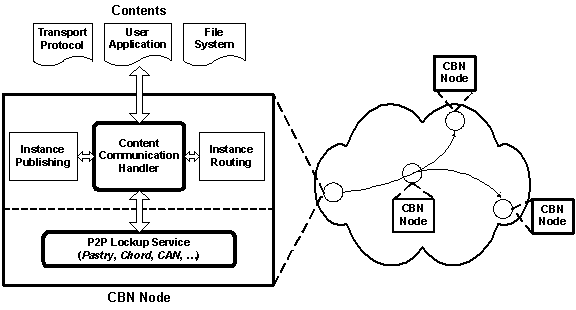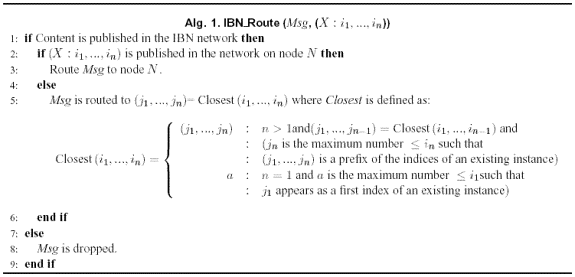    
| |
  
We propose a new Instance-Based Network (IBN). The proposed
network provides the flexibility of having different instances of the same
content. It is up to the user of the IBN network to define the relation between
these instances. For example, a file archiving system can use the new IBN to
store different versions of the same file. Here, the file name represents the
common content and the different versions represent the different instances of
the same file. A user of this file archiving system may want to query for a
particular version of the file (instance) or ask for the latest version of the
file. This feature is unique in the proposed IBN compared to any P2P lookup
service.
Features/Goals

The proposed
IBN (whose components are shown in the above figure) extends the functionality
of the current peer-to-peer lookup services, which provides a mechanism to map a
content identifier to a node assigned by the IBN. These extended functionalities
are:
 | Content-node
mapping: The
IBN user can ask the IBN to map a content to a particular node (through a
publish operation). All mapping are leased, that is, if the user does not
refresh the lease before it expires, the content is removed from the IBN.
|
 | Content
communication:
Application endpoints, defined by contents, can send messages to other
content-identified endpoints.
|
 | Instance-based
routing: The
IBN can route a message to a specific content instance or to the nearest
instance (the neighborhood metric is defined below) if no exact match is
found for the destination content instance.
|
 | Replication: The IBN replicates the stored contents in order to provide fault
tolerance.
|
 | Caching:
Nodes along the query path can cache a content to provide fast answers to
future queries.
|
Addressing

A content of
the new IBN is addressed using a name X and an instance identifier (i1,
i2, …., in),
where i1,
…, in are n integer
numbers (as shown in the above figure). We use the notation (X
: i1,
…, in) to refer to an instance of a content X.
The semantics and dimensionality (n)
of the instant identifier tuple is assigned by the user of the IBN network.
These semantics include the ordering relation between different instances. For
example, in a file archiving system, a file name can be represented as (logfile : 1; 0; 1)
to represent the version 1.01 of the file logfile. These
semantics are assigned by the file archiving system.
The user of the IBN
network maps a content instance to a particular node. The next section describes
how the routing is performed in the proposed IBN.
Routing
The routing
in the proposed IBN network is instance-based. A message destined to content (X : i1,
…, in) is routed to the nearest published instance of the same content X to the destination instance. The routing algorithm of the IBN is
illustrated in Algorithm 1. The function Closest in the algorithm
represents one possible ordering relation between different relations. This is
the comparison function used by the ATP protocol. The proposed IBN extends the
routing techniques of the current P2P lookup services. Appendix B shows the API
that the IBN network exports to upper layers.

Back to Top
|

